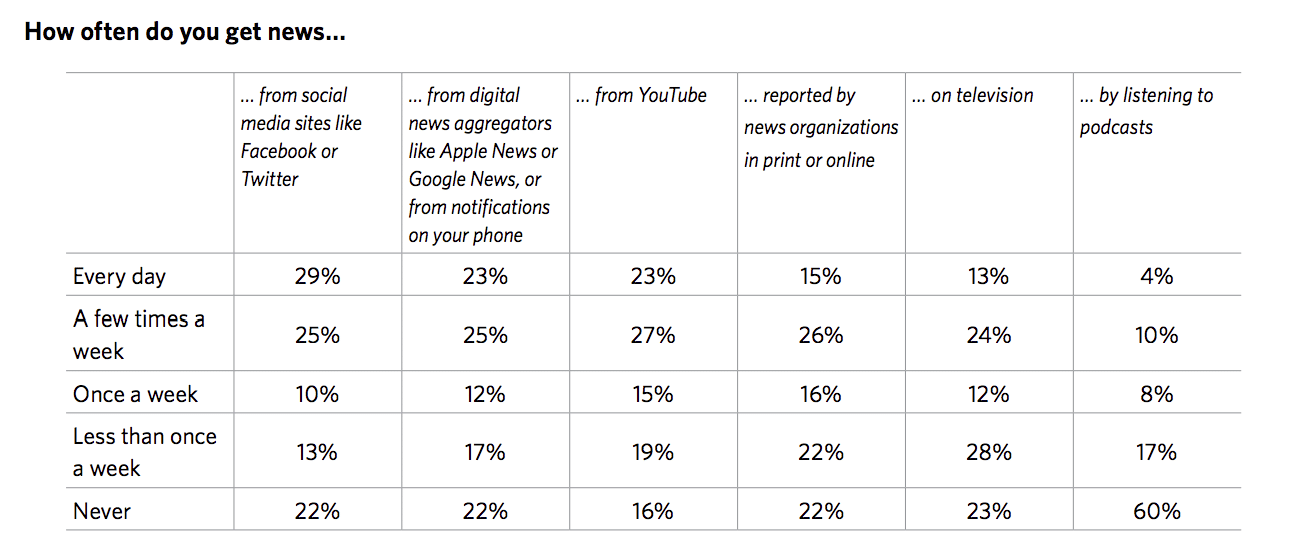The teen trends of today are often indicators of the leading trends of tomorrow throughout the general population, and new research from media trust advocates Common Sense and SurveyMonkey paints a bleak picture for traditional media outlets, even those making adjustments in the digital age.
According to the groups’ new study, teens today are not only getting the majority of their news online, but they are turning away from traditional media orgs to find out about current events on social media sites and YouTube, often from online influencers and celebrities.
The survey found that a large majority of teens age 13 to 17 in the U.S. (78 percent) say it’s important to them to follow current events, but more than half of teens (54 percent) get news at least a few times a week from social media platforms such as Instagram, Facebook and Twitter, while 50 percent get news from YouTube.
Teens’ news habits reflect the diversity of the modern media landscape
And, while most news organizations maintain accounts on social media and other platforms, they are competing for attention with corporate brands, celebrities, influencers, and personal connections. Of those teens who get their news from YouTube, for example, six in 10 say they are more likely to get it from celebrities, influencers, and personalities rather than from news organizations utilizing the platform.
What’s noteworthy is that, even with so many relying on alternative sources for the majority of their news, teens are more confident in the news they get directly from news organizations. Of teens who get news of current events from news organizations, 65 percent say it helps them better understand what is going on. In contrast, just 53 percent of teens who get news from social media say it helps them better understand what is going on, while 19 percent say it has made them more confused about current events.
Amid ongoing concerns about the impact of information disseminated through social media on elections, older teens’ news habits may have political implications. Of the teens age 16 and 17 who say they’ll be eligible to vote in the 2020 election, 85 percent are likely to cast a ballot, including 61 percent who say they’re “very likely.”
“These findings raise concerns about what kind of news the next generation is using to shape their decisions,” said James Steyer, CEO of Common Sense, in a news release. “There are few standards for what constitutes news and how accurately it’s portrayed on the platforms teens use. With the 2020 election coming up, we need to make sure teens are getting their news from reliable sources, thinking critically, and making informed decisions.”
This latest survey is part of a Common Sense partnership with SurveyMonkey to examine media and technology trends affecting kids and their parents and to share actionable data and insights with families.
“While it’s notable that teens rely heavily on platforms such as Facebook and YouTube to stay informed, their reliance on news from celebrities and influencers rather than journalists may have pernicious implications,” said Jon Cohen, chief research officer at SurveyMonkey, in the release. “It’s a bit of a paradox: Overwhelmingly teens say they are interested in keeping up with the news, but they’re not seeking out either traditional or new media to do so.”
Additional key findings:
Teens get their news more frequently from social media sites (e.g., Facebook and Twitter) or from YouTube than directly from news organizations
More than half of teens (54 percent) get news from social media, and 50 percent get news from YouTube at least a few times a week. Fewer than half, 41 percent, get news reported by news organizations in print or online at least a few times a week, and only 37 percent get news on TV at least a few times a week.
YouTube recommendations drive news consumption
Among all teens who get their news from YouTube—regardless of how often—exactly half (50 percent) say they most often find news on YouTube because it was recommended by YouTube itself (i.e., as a “watch next” video or in the sidebar). Almost half as many (27 percent) say they follow or subscribe to a specific channel for news on YouTube, and fewer say they find their news on YouTube through search (10 percent) or because it was shared by someone they know in real life (7 percent).
Sixty percent of teens who get news from YouTube say they are more likely to get it from celebrities, influencers, and personalities as compared to news organizations (39 percent)
The difference is even more apparent among daily YouTube news consumers (71 percent vs. 28 percent).
Nearly two in three teens (65 percent) who get news directly from news organizations say doing so has helped them better understand current events
This is compared with 59 percent of teens who get their news from YouTube (56 percent) and 53 percent who get their news from social media sites (53 percent). Nearly two in 10 teens (19 percent) say that getting news from social media has made them more confused about current events.
Teens clearly prefer a visual medium for learning about the news
A majority (64 percent) say that “seeing pictures and video showing what happened” gives them the best understanding of major news events, while just 36 percent say they’d prefer to read or hear the facts about what happened.
Politically, teens are more likely to be moderate and identify as Democrats, but they are open to ideas from sources whose opinions differ from their own
Just under half of teens (45 percent) say they get news from sources that have views different from their own once a week or more, and only 14 percent say they never get news from sources with different views. Slightly fewer (35 percent) say they discuss political issues with people who have different views once a week or more, and 19 percent say they never discuss politics with people who have opposing views.
The study comes on the heels of the release of Common Sense’s revamped Digital Citizenship Curriculum, which gives teachers lessons to help students develop skills to be critical consumers of news at a time when they are navigating a fast-changing digital terrain fraught with fake media, hate speech, cyberbullying, and constant digital distraction.
This SurveyMonkey Audience survey was conducted June 14 to 25, 2019, among 1,005 teenagers age 13 to 17 in the United States. Respondents for these surveys were selected from more than 2 million people who take surveys on the SurveyMonkey platform each day. The modeled error estimate for the full sample is +/-4.0 percentage points. Data has been weighted for age and sex using the Census Bureau’s American Community Survey to reflect the demographic composition of people in the United States age 13 to 17.












